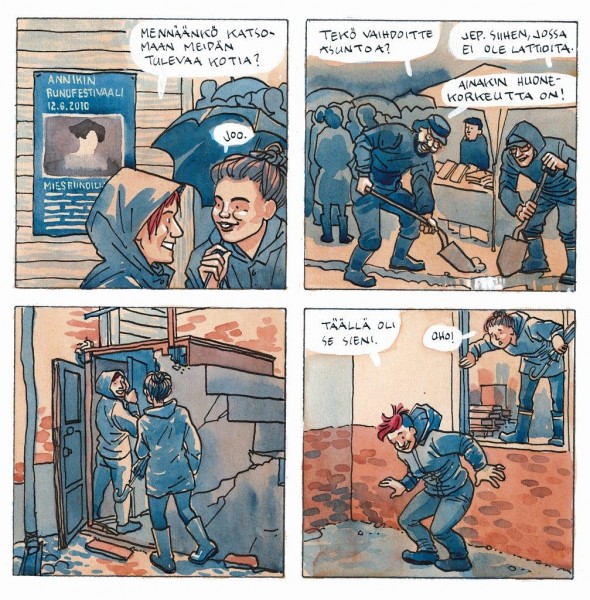Archive for April, 2015
New from the archive
30 April 2015 | This 'n' that
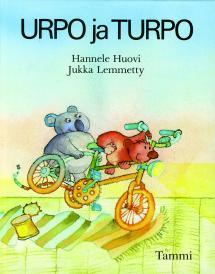 The first of Hannele Huovi’s much loved Urpo ja Turpo (‘Urpo and Turpo’) books – featuring two little bears, the grey, bob-tailed Urpo, who likes flowers, and Turpo, the grey, intrepid adventurer – appeared in 1987.
The first of Hannele Huovi’s much loved Urpo ja Turpo (‘Urpo and Turpo’) books – featuring two little bears, the grey, bob-tailed Urpo, who likes flowers, and Turpo, the grey, intrepid adventurer – appeared in 1987.
With comically characterised illustrations by Jukka Lemmetty, these vignettes cast a philosophical light on life as seen from a small child’s viewpoint, whether the subject is monsters at bedtime, what to play on a rainy day, using the family dog as a sailing ship or learning good manners.
Hannele Huovi (born 1949) won the prestigious Eino Leino Prize in 2009. Her work has been translated into Swedish, Danish, Norwegian, Estonian, German, Japanese, Russian and Arabic.
Friendly voices
27 April 2015 | Letter from the Editors
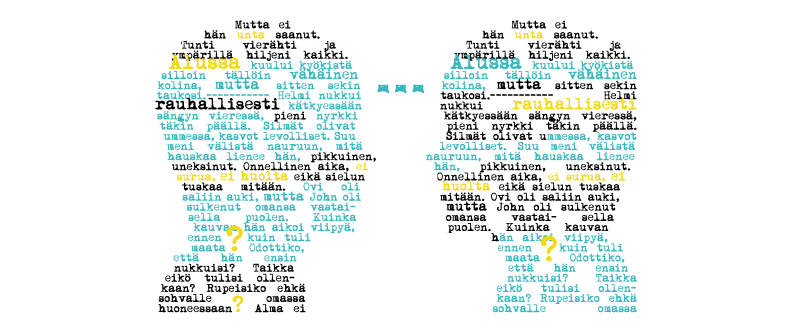
No one could call reading – or writing, for that matter – a social activity. No matter how many reading, or writing, groups you may choose to join, the actual engagement with a book is something you do alone.
Music, theatre, cinema, dance – those really are social enterprises. You can go to them together; you can watch them together, at the same time; you can talk about the experience you’ve shared. Even computer games, which sometimes seem to their elders to be making solipsists of all our children, are social, even if the ‘friends’ they play with may be the other side of the world, and may not speak the same language.
You’re never alone with a good book, as the advertising slogan says. But you’re not exactly in company, either… except…. More…
Moomins on the beach
23 April 2015 | This 'n' that
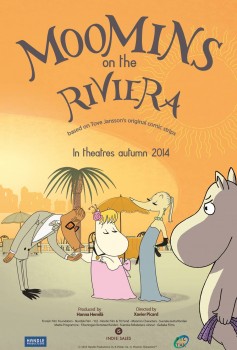 A new, Finnish-French, animated movie sees the Moomin family caught up in a typhoon that lands them among the fleshpots of the French Riviera.
A new, Finnish-French, animated movie sees the Moomin family caught up in a typhoon that lands them among the fleshpots of the French Riviera.
Based not on Tove Jansson’s children’s books, but on a cartoon strip drawn by Tove and her brother, Lars, that ran in the London Evening Standard newspaper between 1954 and 1970, Moomins on the Riviera offers the Moomins a whole host of new experiences.
The plot draws the experiences of Tove and her mother on holiday in the south of France. The bedraggled family takes up residence in the royal suite of the Grand Hotel, where they are initially quite unaware that they will have to pay for the privilege. Moominpappa makes friends with the aristocratic Marquis de Mongaga and affects the surname ‘de Moomin’; the Snorkmaiden, meanwhile, is dazzled by the charms of a playboy by the name of Clark Tresco. Overwhelmed – and worried about how the family can stick together in the face of all these new experiences – Moomintroll and Moominmamma decide to move to the beach, and seek shelter under their shipwrecked boat.
The trailer for the film, which is a co-production between Handle Productions of Finland Pictak of France, shows a hand-drawn animation style which stays very close to Tove Jansson’s original drawings – something which will delight the many Moomin fans who were horrified by the cute, balloon-like characters in the popular Japanese TV animation.
The film’s director is Xavier Picard, and its producer and co-director Hanna Hemilä. It opens in London on 22 May.
Peter von Bagh: Muisteja [Memories]
17 April 2015 | Mini reviews, Reviews
 Peter von Bagh
Peter von Bagh
Muisteja [Memories]
Helsinki: Like, 2014. 426 pp., ill.
ISBN 978-952-01-1093-2
€29.95, hardback
Peter von Bagh (1943–2014) became a cinephile legend in his lifetime. He was the son of a German emigrée, a psychiatrist from St Petersburg; his mother died when he was six, and his stepmother, ‘mean and stupid’, destroyed in his absence all his personal belongings, books and photographs. In this memoir von Bagh contends that his own films were to a large extent a means of reconstructing the past that his stepmother destroyed. Von Bagh was editor-in-chief of Filmihullu (‘Film fan’) magazine for 43 years, published more than 30 books on cinema and its history, worked in radio and for the National Film Archive, and directed dozens of films, mainly for television. He promoted the Midnight Sun Film Festival in Sodankylä, Lapland, for twenty-eight years, and held the post of artistic director of Bologna’s Il cinema Ritrovato festival for thirteen. This book presents the reader with a huge number of people, films, books, encounters and travels; although, typically of von Bagh, who, despite his doctorate, never cared for ‘formalities’, and rather annoyingly, there is no index. (Surely the publisher could have provided them!) But both self-criticism and the acidic, boldly blunt comments on anything – or anybody – that the writer considers ridiculous or stupid, the knowledge and the experience as well as the sardonic humour make the book a very worthwhile experience. The reader is very thankful for the fact that the author was able to finish writing this book of memoirs.
Picture this
9 April 2015 | Articles
It’s impossible to put Finnish graphic novels into one bottle and glue a clear label on to the outside, writes Heikki Jokinen. Finnish graphic novels are too varied in both graphics and narrative – what unites them is their individuality. Here is a selection of the Finnish graphic novels published in 2014
Graphic novels are a combination of image and word in which both carry the story. Their importance can vary very freely. Sometimes the narrative may progress through the force of words alone, sometimes through pictures. The image can be used in very different ways, and that is exactly what Finnish artists do.
In many countries graphic novels share some common style or mainstream in which artists aim to place themselves. In recent years an autobiographical approach has been popular all over the worlds in graphic novels as well as many other art forms. This may sometimes have led to a narrowing of content as the perspective concentrates on one person’s experience. Often the visual form has been felt to be less important, and clearly subservient to the text. This, in turn, has sometimes even led to deliberately clumsy graphic expression.
This is not the case in Finland: graphic diversity lies at the heart of Finnish graphic novels. Appreciation of a fluent line and competent drawing is high. The content of the work embraces everything possible between earth and sky.
Finnish graphic novels are indeed surprisingly well-known and respected internationally precisely for the diversity of their content and their visual mastery.
Life on the block
You thought Finnish was weird?
9 April 2015 | This 'n' that
You thought Finnish was weird?
Just listen to it get a whole lot weirder…
Ever since she burst on to our computer screens a year ago, we’ve been fans of Smokahontas, also known as Sara Forsberg.
Then aged 19, Forsberg shot to fame with her YouTube video What Languages Sound Like to Foreigners, in which she demonstrated a mastery of fluent gibberish in 14 languages including Japanese, estuarine English, French, Italian, Arabic…. She followed this up with One Girl, 14 Genres, where she bent her considerable talents for mimicry to performances in fourteen musical genres, from R ‘n’ B to musical, from traditional Indian to hipster indie.
An appearance on the Ellen de Generes show, and much media attention, followed, and Forsberg moved to California to pursue her career… where, one rainy day, thinking of home, she turned her attention to the Finnish language.
The result is Learn Finnish with Sara, a hilarious exploration of some of the sillier aspects of Finnish. It’s one of the most difficult languages in the world to learn, says Forsberg, and she goes on to prove it with some wacky examples. Vihdoin vihdoin vihdoin means ‘I finally whipped myself with boughs of silver birch; for Kokko, kokoo koko kokko kokoon, you’ll just have to watch the video. Not to mention hurskastelevaisehkollaismaiselllisuuksissaankohan hän toimii…
We’re predicting a big career. In whatever language.
New from the archive
9 April 2015 | This 'n' that

Tove Jansson. Photo: Hans Gedda
After she stopped writing the Moomin stories in 1970, Tove Jansson (1914-2001) began an entirely new career as the author of fiction for adults. This story, ‘Summer child’, comes from her third volume of short stories for adults, Resa med lätt baggage (Travelling light, 1988), where travelling – even if only by motor boat, between the islands of the archipelago that lies off Finland’s south-west coast – is the central theme.
‘Summer child’ tells the story of what happens when Elis, a morbidly serious little boy, spends the summer with a family in the Finnish archipelago. His gloomy world-view disquiets the cheerful Fredriksons to such a degree that in the end their differences can only be settled by violence….
*
The same story is republished, in a different translation, by Sort Of Books of London, with an introduction by the Scottish writer Ali Smith. For Smith, this tale of a young lad, ‘well-informed about everything that’s dying and miserable’, amid the idyllic landscapes of the Finnish summer, is ‘a fable about innocence and knowledge’; the book itself is ‘one of [Jansson’s] funniest, most unputdownably airy works’.
Ali Smith is far from being the only fan of Jansson’s work for adults. Sort Of Books has now published a total of seven volumes of her short stories, memoirs and novels, and her fame has also spread to the United States, where her Moomin books are much less well-known. Her The True Deceiver won the Best Translated Book Award in 2011, and has appeared on Publisher’s Weekly’s list of ‘The 20 Best Books in Translation You’ve Never Read’. It’s in good company – other books include Thomas Bernhard’s Concrete, Knut Hamsun’s Mysterie, Dubravka Ugresic’s The Museum of Unconditional Surrender and George Perec’s Life, A User’s Manual.
H. K. Riikonen: Nukuin vasta aamuyöstä. Olavi Paavolainen 1903–1964 [I didn’t fall asleep until morning. Olavi Paavolainen 1903–1964]
9 April 2015 | Mini reviews, Reviews
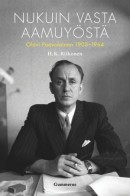 Nukuin vasta aamuyöstä. Olavi Paavolainen 1903–1964
Nukuin vasta aamuyöstä. Olavi Paavolainen 1903–1964
[I didn’t fall asleep until morning. Olavi Paavolainen 1903–1964]
Helsinki: Gummerus, 2014. 584 pp., ill.
ISBN 978-951-20-9714-2
€36.90 , hardback
In the 1920s and 1930s the author and journalist Olavi Paavolainen was a prominent cultural figure among young writers and artists. Published after the Second World War, his controversial war diary, Synkkä yksinpuhelu (‘Sombre monologue’, 1946), remains his best-known literary work. This book, by Professor of Literature H.K.Riikonen, focuses on Paavolainen’s literary activities and his oeuvre; it complements and deepens another biography of Paavolainen published in 2014, Tulisoihtu pimeään (‘A torch into the darkness’) by Panu Rajala. Riikonen thoroughly examines Paavolainen’s works as well as his post-war career as a director at the Finnish Broadcasting Company. At times Riikonen’s views, based on careful research, differ from Rajala’s interpretations. Riikonen also features the cultural life and eminent contemporary figures of Paavolainen’s era. At times the text, with its precise references and culture-historical details, meanders somewhat. The book includes plenty of quotes from Paavolainen’s works as well as interesting fact boxes related to the circumstances of his life.
In memoriam Austin Flint (1931–2015)
2 April 2015 | In the news

Austin Flint
The playwright, teacher and translator Austin Flint died in New York on 1 February.
Austin was Adjunct Professor in the Department of Arts at Columbia University, New York, and taught playwriting there for almost half a century. Among the translations from Finnish into English he made – together with his wife Aili Flint – are the novel The Parson’s Widow (Hänen olivat linnut) by Marja-Liisa Vartio and the play Anna-Liisa by Minna Canth.
Austin’s plays include: The Flaming Spider: Jonathan Edwards in Northhampton, Prison Light, Marching to Jubilee: William Lloyd Garrison’s Campaign for the Abolition of Slavery and Compartments. His work has been performed in New York and at Yale University.
Austin Flint was a member of the Editorial Advisory Board of Books from Finland from 1985 to 1995. With Aili – whom he met in 1958 in Helsinki, where he was teaching – he translated many articles and extracts for the journal.
The Flints acted as hosts in 1986 when the Editorial Board of Books from Finland visited New York to discuss the development of the journal with them and a few selected literary figures. The Editorial Board found Austin’s expertise and interest in making Finnish literature better known in the United States most useful and encouraging. We remember Austin as a warm-hearted collaborator whose gentle humour greatly enlivened the editorial process.
Hannu Rautkallio: Mannerheim vai Stalin. Yhdysvallat ja Suomen selviytyminen 1939–1944 [Mannerheim or Stalin. The United States and Finland’s survival 1939–1944]
2 April 2015 | Mini reviews, Reviews
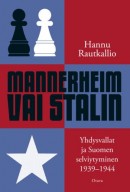 Mannerheim vai Stalin. Yhdysvallat ja Suomen selviytyminen 1939–1944
Mannerheim vai Stalin. Yhdysvallat ja Suomen selviytyminen 1939–1944
[Mannerheim or Stalin. The United States and Finland’s survival 1939–1944]
Helsinki: Otava, 2014. 463 pp., ill.
ISBN 978-951-1-27394-3
€39.70, hardback
In his book political historian Hannu Rautkallio explores American attitudes towards Finland during the Second World War, when the country fought a Winter War and Continuation War against the Soviet Union. He makes use both of older materials and of American documents that have only become accessible to researchers in the 2010s. During the war years two trends were dominant; one was sympathetic to the aims of the Soviet Union, while the other took a hostile view of them. The US political leadership had refused to support Finland in the Winter War, but as the World War progressed the United States tended to understand the small country’s objectives and also the special nature of its alliance with Germany. The two states shared intelligence and there were a large number of secret contacts with Finland’s top government leadership. At the end of World War II, the United States communicated to the Soviet Union, which was dictating peace terms to Finland, that it was important Finland should remain an independent state. Rautkallio’s account keeps branching out along interesting side-tracks, but the book’s central theme captures the reader’s interest.
Translated by David McDuff
Ville Laamanen: Suuri levottomuus. Olavi Paavolaisen kultturinen katse ja matkat 1936-39 [A great restlessness. Olavi Paavolainen’s cultural gaze and travels 1936-1939].
2 April 2015 | Mini reviews, Reviews
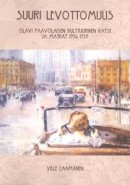 Ville Laamanen
Ville Laamanen
Suuri levottomuus. Olavi Paavolaisen kultturinen katse ja matkat 1936-39 [A great restlessness. Olavi Paavolainen’s cultural gaze and travels 1936-1939].
Turku: K&H, 2014. 346p., ill.
ISBN 978-951-29-5632-6
€32, paperback
The writer Olavi Paavolainen (1903-1964) was an important cultural critic in Finland in the years between the two World Wars. The historian Ville Laamanen’s doctoral thesis Suuri levottomuus explores how Paavolainen interpreted the encounter between the modern and totalitarianism. Laamanen examines Paavolainen’s journeys to National Socialist Germany and South America, where he was able to gain distance from Eurocentricity. Paavolainen published three books on the basis of these journeys, and these form the central sources for Laamanen’s research. The outbreak of the Winter War in Finland in 1939 prevented the publication of a fourth volume. This work would have focused on the Soviet Union, which at that point was little-known. The most important offerings of Laamanen’s book are the research results based on material from Russian archives which has hitherto remained unexamined. Paavolainen was not a communist, but was accorded VIP status in the Soviet Union and was able to gain a diverse view of the country. Laamanen also places Paavolainen in the broader cultural context of the 1930s. The book is at the same time a rigorous academic study and a well-written, gripping portrait of a still interesting Finnish intellectual during an important period.

